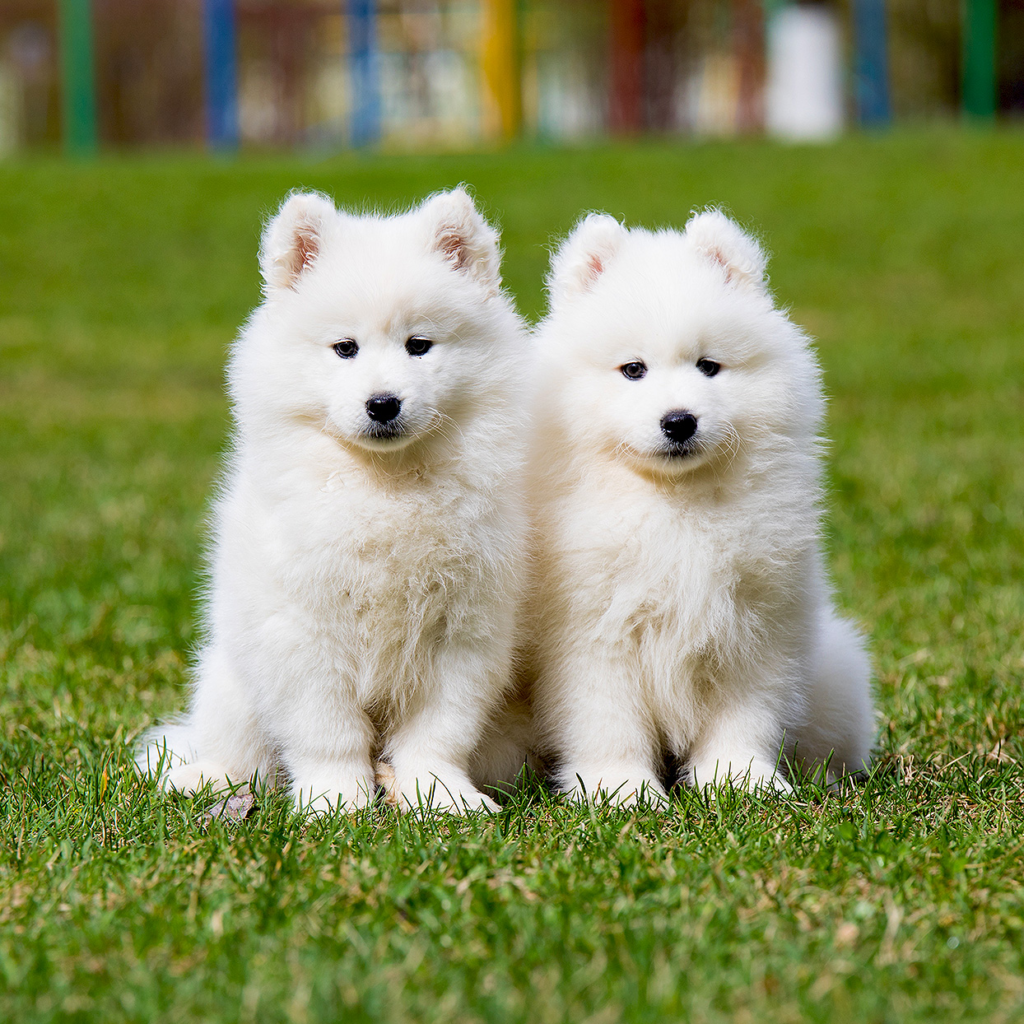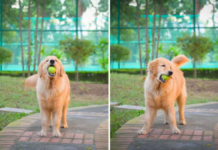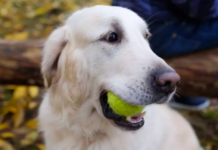Last Updated on September 3, 2023 by Fumipets
Samoyed Dogs: Fluffy Companions of Arctic Charm
Samoyed introduces us to the enchanting world of these fluffy and friendly Arctic dogs. Samoyeds are known for their striking appearance, characterized by a fluffy white coat and a captivating smile.
This summary explores the breed’s history, distinctive characteristics, care requirements, and the endearing qualities that have made Samoyeds beloved family pets and working dogs for centuries.
Samoyed Dogs
One of the many intriguing things to learn about this extroverted, perceptive, and jovial northern canine is how to say the Samoyed. You might hear it pronounced Sammy-ed, Sa-moy-ed, or Samm-ah-yed depending on where you reside. All of them are accurate, but calling them “Sammies” or “Sams” is equally natural. Whatever you want to name them, they are all stunning snowballs of joy and vigor with stubborn work habits.
Appearance
It’s remarkable to see a Samoyed with so much startlingly white hair. If they remained motionless, from the points of their trapezoidal ears to the end of their curled, arching tail, they might have been confused for an immaculate snowdrift in a Nordic environment. Purebred Sams can also be found with equally gorgeous cream and biscuit uniform color coats, as well as beautiful white and biscuit combos.
Sams have a thick, weather-resistant double garment with a smooth underlayer that shields them from below-freezing temps. They have short, stocky legs and are very strong, eager to leap into action. They stand at almost two feet tall and can weigh as little as 35 pounds for females while some males can weigh up to 60 pounds. A Sam is roughly the same length as he is tall, with broad shoulders and a dense fur fringe.
These friendly dogs are appropriately referred to as “Smiling Sammies.” Their raised lips and short snouts, which are elevated to prevent icicles from developing at the corners, produce natural looks of amusement. When extremely enthusiastic, their dark black or brown oval eyes sparkle and they frequently prancing a little.
Temperament
It’s a lovely and surprising relationship when a canine partner pushes you to keep moving. With a Samoyed, you have that. Despite all of his eccentricities—and, unfortunately, his frequent barking—he acts as a furry movement-focused life counselor who frequently encourages the people he loves to run, retrieve, cycle, sled, trek, and play sports.
Samoyeds and other arctic-adapted dogs are frequently capable of handling more demanding activities like agility competitions, dog-assisted cross-country skiing, and snowmobiling. There is no reason not to challenge Sam’s mind and body in this manner as long as a doctor gives him the all-clear. He excels at task-oriented activities because they keep him engaged and cheerful while reducing tedium. A finicky, trouble-prone Sammie who is restless may even pull out his hair if he becomes upset.
When your Samoyed dog is between 10 and 12 weeks old and has received all of his vaccinations, it’s a good idea to enroll him in puppy school. Among the many skills he’ll need to develop are leash training, cage fitness, and crucial sociability. Even though he’s younger than that, he’s still anxious to make pals, so expose everyone to the group as soon as you can, particularly kids, animals, other canines, and your acquaintances.
The same autonomous attitude that helps him when carrying provisions across the desolate wasteland could be a problem during training if you don’t establish yourself as the pack leader. Sams are highly clever but frequently stubborn, even though they usually want to win your favor. You must be kind, strong, and constant in your approach to positive feedback and no-fear teaching. It’s advisable to periodically seek the assistance of a behaviorist even after attending puppy school for a year or more, or if you adopt a mature shelter dog. This will ensure that both you and your Samoyed continue to learn new skills and rules for compliance.
Vocalization that is efficient also benefits from training. Sams communicate with you through yips, woofs, and snorts, among other striking body language signals. They do, however, growl. A lot. Both you and your friends won’t enjoy it. The Samoyed Club of America advises using rewards and belly massages as form of positive feedback while teaching him the worth of instructions like “settle” and “quiet.”
A Sammie is a genuine family-oriented dog who loves to play outside and lead kids around. However, when it’s time to cuddle up by the fire inside, he’s a soft, contented cushion, happy to have his family around him. He always has his people’s best interests in mind thanks to his keen, attentive demeanor, and his growls let you know when something is wrong. But he’s also accepting and cordial to anyone who drops by, particularly if you fostered interpersonal abilities in children from an early age.
If you really want to make your Sammie unique, think about teaching him how to be a service dog. His kind nature makes him a popular guest at care facilities that take part in the program, and he will enjoy the additional pats and embraces from residents.

Living Needs
clever and cunning Samoyed canines are great at solving problems, which is a talent that is highly prized in the outdoors but not in your garden. Sams will locate a crevice in a barrier, enlarge it, crawl through it, and vanish into thin air. Use strengthened high netting that is deeply embedded in the ground to give Sammie a safe area to wander rather than constantly leashing him or crating him—both of which a determined Sammie will gnaw through.
Many polar canines, like Sams, have natural burrowing tendencies because their forebears used to build their homes in thick snow. By taking your Sammie on an excavation date in an area where it is permitted, like a canine park, the shore, or the forests, you can use this habit more effectively. It might also be possible to designate a specific area of the yard as his particular play area. Treats and trinkets can teach him to limit his digging to this region.
A Sammie usually gets along with residing in an apartment because of his love of cuddling up with his human friends. He needs rigorous activity a few times per day, and his howling might be deemed annoying. So in many ways, having a private open area that is easily available makes him happy and healthy.
A Samoyed requires people who can keep up with him readily because of his active but not excessive disposition. These dogs enjoy running after smaller dogs, cats, outdoor animals, and other canines. A bad outcome from such a situation might necessitate your involvement. However, medium to large-sized canines of the opposing species make excellent playmates.
Care
These types of double-coated canines need more grooming time than other varieties. One of the reasons the Samoyed is called a cloud dog is because of how much hair he sheds—snow-white fur drifts everywhere!
They require daily care in the spring and autumn when their coat is undergoing its yearly change known as “blowing coat,” as well as routine grooming to keep continuing flaking under control. Although Sammies in cooler climes have fewer reasons to sweat, you’re still not entirely off the hook. Keep a slicker brush, metal comb, pin brush, and an expert groomer’s number handy.
Fortunately, Samoyeds only need to take a wash every three months or so due to their exceptionally spotless hair. Some individuals use special cleansers to maintain their hair completely immaculate if it is. Other fundamental care includes weekly ear checks, foot trimming, and frequent tooth cleansing with canine paste. Getting into a healthy habit can be helped by a veterinary.

Health
The majority of Samoyeds are healthy, strong dogs. However, they are susceptible to specific medical conditions like hip dysplasia, a hereditary musculoskeletal disorder that results in arthritis, discomfort, and bone deterioration, just like all sled-pulling canines. A doctor may prescribe specific medicines and joint health nutrients for minor cases, but surgery is frequently needed for more serious cases.
Be cautious when giving gifts to your Samoyed because maintaining a healthy weight is crucial for both general care and protection.
Sams are prone to overheating in hotter climes, so they shouldn’t be kept outside for an extended period of time. They might need to remain by a moving fan to chill off when they enter. A Samoyed should stay inside if it feels sweltering and muggy to you because they are already unpleasant. Schedule your exercise sessions for the early morning or later in the day when it is cooler.
The Samoyed does exceptionally well in more mild temps, as long as he can exercise all year round, for a canine whose forebears survived in sub-zero Siberian conditions. In colder climes, you don’t necessarily have to hide to appreciate his companionship. And given that Sammies live 12 to 14 years, you will for a very long period.
History
Samoyeds are canines that belong to the Nordic spitz breed, which has Asian roots. One of 14 breeds with clear connections to prehistoric wolves is the samoyed. According to Becker, Samoyeds have a lengthy and complex past as a component of Samoyedic civilization in Siberia. For the indigenous people, these canines played a crucial role in their families, accompanying them in their homes to offer essential comfort and affection.
Sams have innate inclinations for grazing because their Siberian forebears assisted the wandering Samoyede people in their searches for reindeer, claims the Samoyed Club of America. Samoyedes, who lived in the far northern regions of the icy earth, raised these canines to be strong transporters and proficient predators as well as close friends for their young.
In the late 1800s and early 1900s, during what is known as the Heroic Age of Antarctic Exploration, teams of dependable Samoyeds guided intrepid travelers. Famous adventurers like Ernest Shackleton, Roald Amundsen, and Robert Falcon Scott were among the group’s companions.
During this period, Sams gained popularity as a show canine and friend. Queen Alexandra of England also developed a passion for the species. In shelters all over the United States, Canada, and Great Britain, you can find the offspring of many of her canines.
Questions & Answers:
What are the origins of the Samoyed breed, and how were they traditionally used by the Samoyedic people?
Samoyeds originated from Siberia, where they were bred by the Samoyedic people for herding reindeer, pulling sleds, and providing warmth as loyal companions.
What makes Samoyeds unique in terms of appearance, particularly their “smile”?
Samoyeds are known for their “Sammy smile,” which is a natural curling of their lips that gives the appearance of a friendly grin. They have a fluffy, double-layer coat that provides insulation against the cold.
What is the temperament of Samoyed dogs, and how do they typically interact with their owners and children?
Samoyeds are known for their friendly, gentle, and affectionate nature. They form strong bonds with their owners and are generally good with children due to their patient and playful disposition.
Do Samoyeds require a lot of grooming due to their thick coat, and how do they handle warm weather?
Samoyeds have a dense coat that requires regular brushing to prevent matting. While they thrive in cold climates, they can adapt to warmer weather with proper care, including shade and access to water.
Are there any common health concerns associated with Samoyed dogs, and what steps can owners take to ensure their well-being?
Samoyeds can be prone to certain genetic conditions, including hip dysplasia and progressive retinal atrophy. Regular veterinary check-ups, a balanced diet, exercise, and dental care contribute to their overall health and well-being.


















